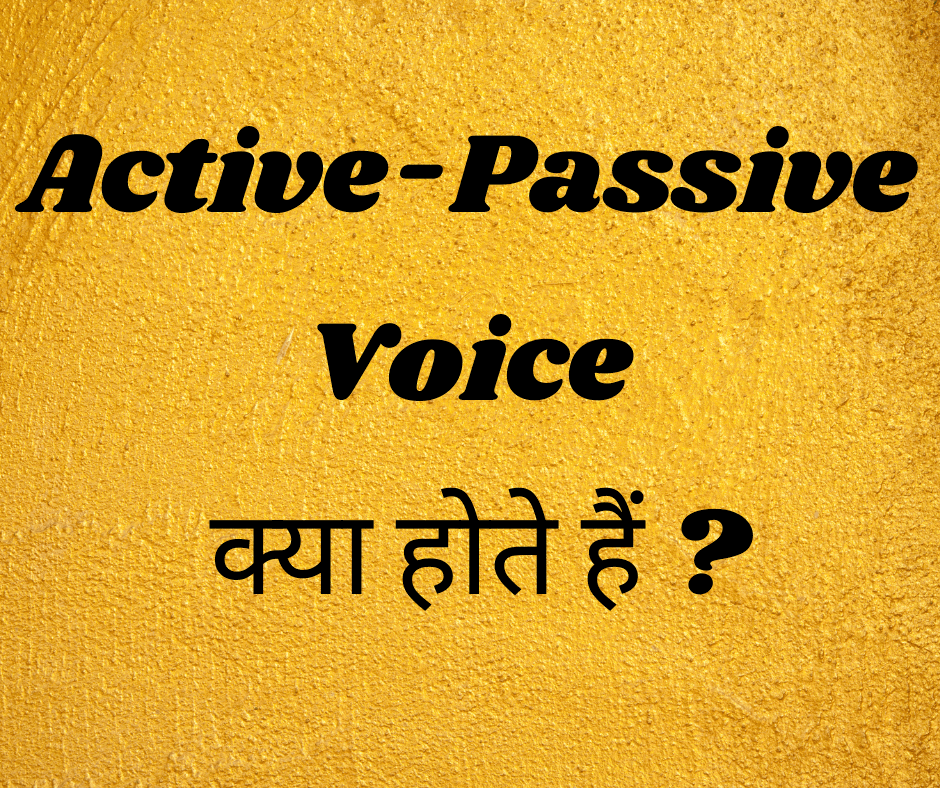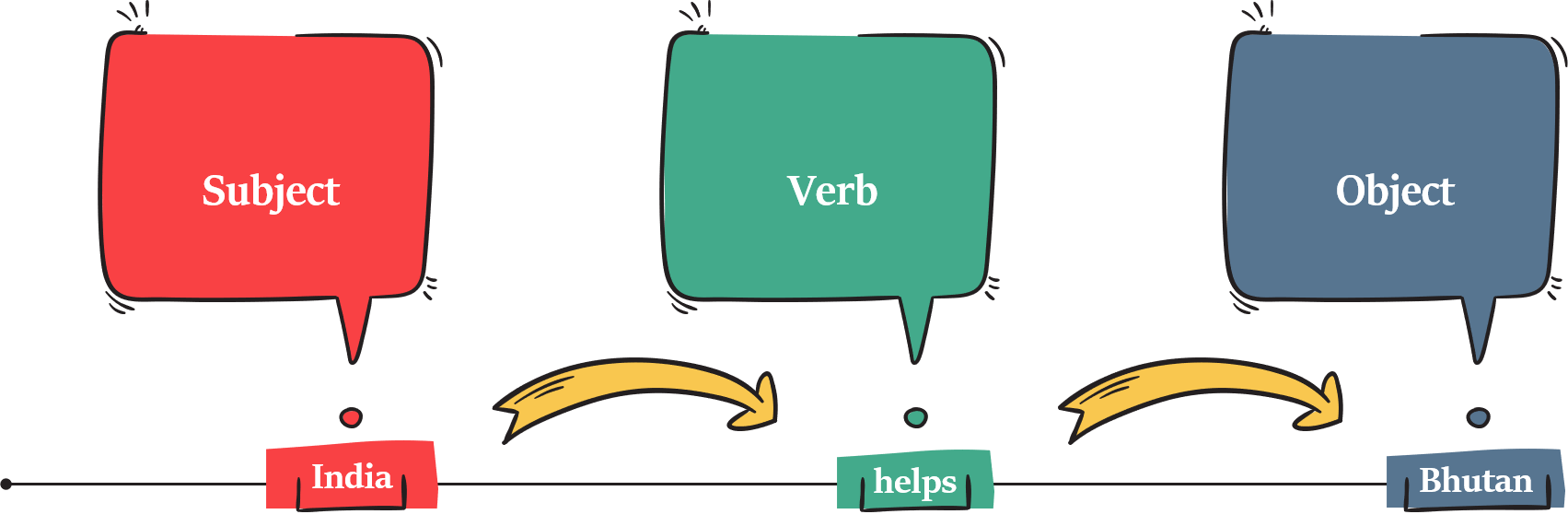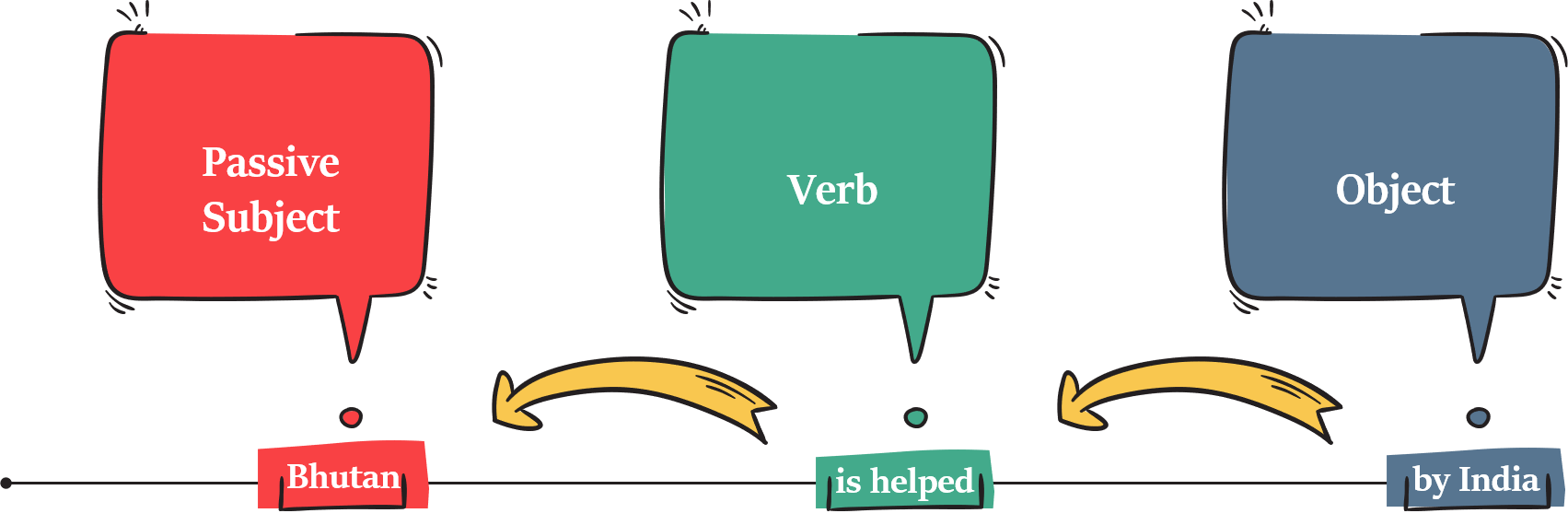Active-Passive Voice क्या होते हैं? (Active-Passive Voice kya hote hein ?)

Overview
इस लेख में हम अंग्रेजी के एक महत्त्वपूर्ण अध्याय के बारे में जानेंगे - Active-Passive voice in Hindi (हिंदी में)
अंग्रेजी व्याकरण में, क्रियाओं (Verbs) में निम्नलिखित गुण होते हैं:
- संख्या (Number) - एकवचन, बहुवचन
- व्यक्ति (Person) - I, II, और III
- काल (Tense) - अतीत, वर्तमान
- Mood
- Voice - Active, Passive
इस मॉड्यूल में, हम Voice पर ध्यान देंगे। हालाँकि, इसे बेहतर ढंग से समझने के लिए, छात्र को क्रिया (Verbs) और काल (Tenses) का कुछ बुनियादी ज्ञान होना चाहिए।
Voice क्या है?
Voice - क्रिया का एक रूप, जो दर्शाता है कि Subject कुछ करता है या उस पर कुछ किया जाता है।
Voices के प्रकार
Active Voice
यदि क्रिया के रूप से पता चलता है कि Subject कुछ करता है (Subject क्रिया का कर्ता है, अर्थार्थ वह सक्रिय है)।
Active Voice Pattern: Subject + क्रिया (Verb) + Object
India helps Bhutan. (Indian – subject; helps – क्रिया (Verb); Bhutan - object)
Passive Voice
यदि क्रिया के रूप से पता चलता है कि Subject पर कुछ किया जाता है (Subject कुछ क्रिया प्राप्त करता है, अर्थार्थ वह निष्क्रिय है)।
Passive Voice Pattern: Subject (passive) + सहायक क्रिया (Helping verb) ‘be’, Tense के अनुसार + \(V_3\) + by + Object
Bhutan is helped by India. (Bhutan – passive subject; is – सहायक क्रिया (Helping verb); helped – \(V_3\); India – preposition ‘by’ का object)

तो Passive voice बनाने के लिए हम उपयोग करते हैं: be + \(V_3\) (Past Participle)
 नोट
नोटकभी-कभी हम 'to get' या 'to have' क्रिया का उपयोग करके भी passive voice बनाते हैं ('to be' क्रिया का प्रयोग करने के बजाय)।
आइए इन दो वाक्यों को फिर से देखें:
Active Voice: India helps Bhutan. (Indian – subject; helps – क्रिया (verb); Bhutan - object)
Passive voice: Bhutan is helped by India. (Bhutan – passive subject; is – सहायक क्रिया (Helping verb); helped – \(V_3\); India – preposition ‘by’ का object)
Passive voice में, active voice का subject 'by' preposition का object बन जाता है। यह अब objective case में होगा, न कि subjective case में।
 नोट
नोटध्यान दें, हालांकि आम शब्दों में हम कहते हैं कि active voice का subject, passive voice में object बन जाता है, लेकिन तकनीकी रूप से यह क्रिया का नहीं 'by' preposition का object बनता है।
इसी तरह, passive voice में, active voice का object, passive subject बन जाता है। यह अब subjective case में होगा, न कि objective case में। Passive voice में सहायक क्रिया (helping verb) passive subject की संख्या (number) और व्यक्ति (person) से सहमत होगी।
 नोट
नोटPassive voice में, 'by' preposition के object को कर्ता (Doer, Agent) भी कहा जाता है (क्यूंकि यह क्रिया करता है)।
इसी तरह, passive voice में, passive subject को Receiver (या Patient) भी कहा जाता है (क्योंकि passive voice का subject passive है, यह क्रिया प्राप्त करता है)।
तो, हम passive voice पैटर्न को निम्नानुसार भी लिख सकते हैं:
Passive Voice Pattern: Receiver + Helping verb ‘be’ (Tense के अनुसार) + \(V_3\) + by + Doer
Bhutan is helped by India. (Bhutan – passive subject/receiver; is – सहायक क्रिया (helping verb); helped – \(V_3\); India – preposition/doer का object)
by + object, \(V_3\) के लिए आता है, इसलिए इसे \(V_3\) के पास रखा जाना चाहिए।
बीच में एक या दो शब्द आ सकते हैं, लेकिन ‘by + object’, \(V_3\) से ज्यादा दूर नहीं होना चाहिए।
Active voice: He writes a letter here.
Passive voice: A letter is written here by him.
 नोट
नोटयाद रखें कि Voice क्रिया का गुण है, न कि पूरे वाक्य का। यानी यह क्रिया है जो active या passive voice में हो सकती है।
कुछ छात्रों की गलत धारणा है कि एक पूरा वाक्य या तो active या passive voice में होना चाहिए। परन्तु, active voice और passive voice वाली क्रियाएं एक ही वाक्य में भी प्रकट हो सकती हैं।
My grandfather owned a pet Bengal tiger, which was given to him by an Indian king. (owned - active voice में क्रिया; was given - passive voice में क्रिया)
Our songs were considered unconventional, but we always felt a connection with the people in general. (were considered - passive voice में क्रिया; felt - active voice में क्रिया)
Passive Voice बनाने के वैकल्पिक तरीके
हम जानते हैं कि, Passive voice बनाने के लिए हम उपयोग करते हैं: be + \(V_3\) (Past Participle)
परन्तु, कभी-कभी हम 'to get' या 'to have' क्रिया का उपयोग करके भी passive voice बनाते हैं ('to be' क्रिया का प्रयोग करने के बजाय)।
हम ऐसे वाक्य निर्माणों का उपयोग तब करते हैं जब हम अपना काम किसी और से करवाते हैं - काम करने वाले की तुलना में, काम अधिक महत्वपूर्ण होता है। काम करने वाला व्यक्ति अक्सर गुमनाम रहता है।
I must get my car serviced. (get + \(V_3\))
I must have my car serviced. (have + \(V_3\))
आइए कुछ और उदाहरण देखें।
When are you going to get that car serviced?
We are having the room refurbished.
I will get those guns delivered before next spring.
He said he would have my food delivered by midnight.
 नोट
नोटकभी-कभी, passive अर्थ देने के लिए active voice क्रिया का भी उपयोग किया जा सकता है।
उदाहरण के लिए, जब हम क्रिया 'need' का प्रयोग gerund या to-infinitive के साथ करते हैं।
The door needs painting.
The door needs to be painted.
जैसा कि आप देख सकते हैं, यहाँ हमारा ध्यान क्रिया प्राप्त करने वाले व्यक्ति या वस्तु (अर्थात door) पर है, न कि क्रिया के कर्ता पर।
Passive Voice को पहचानना
हम जानते हैं कि Passive Voice बनाने के लिए हम उपयोग करते हैं: be + \(V_3\) (Past Participle)
उदाहरण के लिए, am licensed, is played, are killed, was created, were eaten, has been seen, is being repaired, आदि।हम इस प्रारूप में modals का भी उपयोग कर सकते हैं, अर्थात modal + be + \(V_3\) (Past Participle)
उदाहरण के लिए, might be created, cannot be used, should have been seen, will have been eaten, आदि।परन्तु, be + \(V_3\) (Past Participle) को एक passive voice रूप तभी माना जाएगा, यदि past participle एक क्रिया के रूप में काम कर रहा हो। कभी-कभी, \(V_3\) (past participle) विशेषण के रूप में भी काम करता है। उस स्थिति में, हम इसे passive voice नहीं कह सकते।
यह Passive Voice नहीं है: All the inventions he has ever made in his life have been when he has been drunk. (drunk - यह एक विशेषण है, क्रिया का हिस्सा नहीं)
Passive Voice: I have been drunk under the table by my old college mates. (drunk - यह क्रिया का हिस्सा है)
Indians were scared of drinking tea when it was introduced.
क्रिया 'was introduced' passive voice में है। हालांकि, 'were scared' नहीं है। यहाँ 'scared' क्रिया का भाग नहीं है। यह एक विशेषण है, जिसका अर्थ है afraid। तो, 'were' active voice में है।
Passive Voice को पहचानने की एक ट्रिक
जब Passive Voice को पहचानने की बात आती है तो विशेषज्ञ भी अक्सर गलती कर जाते हैं। लेकिन सौभाग्य से, हमारी मदद करने के लिए हमारे पास एक सरल परीक्षण है।
क्रिया रूप के बाद बस 'by vampires' शब्द शामिल करें। यदि वाक्य का तब भी मतलब निकलता है, तो इसका मतलब है कि क्रिया passive voice में है।
आइए एक उदाहरण देखें।
The bike could have been stolen.
The bike could have been stolen by vampires. (यह समझ में आता है। तो, 'have been stolen' passive voice में है।)
The bike could have been illicit.
The bike could have been illicit by vampires. (इसका कोई मतलब नहीं है। इसलिए, 'have been' active voice में है, और illicit एक विशेषण है।)
'by' के अलावा अन्य Prepositions का प्रयोग
कुछ क्रियाओं के बाद हमेशा एक निश्चित preposition होता है, जो passive voice में 'by' की जगह प्रयोग होता है।
amazed at, amused at something, angry with somebody, annoyed with somebody, annoyed at something, astonished at, comprised of, contained in, crammed with, cut with something, decorated with, embodied in, engulfed in, filled with, interested in, known to, married to, ornamented with, pleased with somebody, pleased at something, satisfied with somebody, satisfied at something, startled at, surprised at, thronged with, tired of, vexed at.
Active voice: He pleased me.
Passive voice: I was pleased with him.
Active voice: The forest fire in California engulfed the whole posh community of Orange county.
Passive voice: The whole posh community of Orange county was engulfed in the forest fire in California.
Active voice: He knows me.
Passive voice: I am known to him.
Surprised (विस्मित होना)
जब कार्रवाई हमारी अपेक्षा के विपरीत थी, तो 'Surprised' के बाद 'at' आता है।
All guests in the party were surprised at his rude behavior.
अन्य सभी मामलों में 'surprised by' का प्रयोग किया जाता है।
Scientists were surprised by the result of the Young's double slit experiment.
Instrument (यंत्र)
हम किसी एजेंट (agent) द्वारा उपयोग किए जाने वाले उपकरण के बारे में बात करने के लिए 'with' का उपयोग करते हैं (by का नहीं)।
तुलना करिये:
Active Voice: Somebody hit the cat with a stick.
Passive Voice: The cat was hit with a stick.
Active Voice: A boy hit the cat.
Passive Voice: The cat was hit by a boy.

अतिरिक्त पुस्तकें और उपकरण
यदि आप किताबों के माध्यम से सीखना पसंद करते हैं, या संदर्भ उद्देश्यों के लिए कुछ अच्छी अंग्रेज़ी व्याकरण किताबें चाहते हैं, तो आप हमारा यह लेख पढ़ सकते हैं|